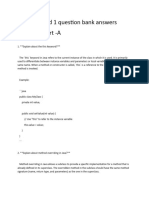0% found this document useful (0 votes)
20 views28 pagesBCA301 Java QUICK REVISION
The document provides a comprehensive overview of Java programming concepts, focusing on Object-Oriented Programming (OOP) principles, control structures, data types, and multithreading. It explains key concepts such as classes, objects, inheritance, encapsulation, and polymorphism, along with examples and code snippets. Additionally, it covers advanced topics like abstract classes, interfaces, packages, and thread management in Java.
Uploaded by
sharmasimran02032003Copyright
© © All Rights Reserved
We take content rights seriously. If you suspect this is your content, claim it here.
Available Formats
Download as PDF, TXT or read online on Scribd
0% found this document useful (0 votes)
20 views28 pagesBCA301 Java QUICK REVISION
The document provides a comprehensive overview of Java programming concepts, focusing on Object-Oriented Programming (OOP) principles, control structures, data types, and multithreading. It explains key concepts such as classes, objects, inheritance, encapsulation, and polymorphism, along with examples and code snippets. Additionally, it covers advanced topics like abstract classes, interfaces, packages, and thread management in Java.
Uploaded by
sharmasimran02032003Copyright
© © All Rights Reserved
We take content rights seriously. If you suspect this is your content, claim it here.
Available Formats
Download as PDF, TXT or read online on Scribd
/ 28
























































































